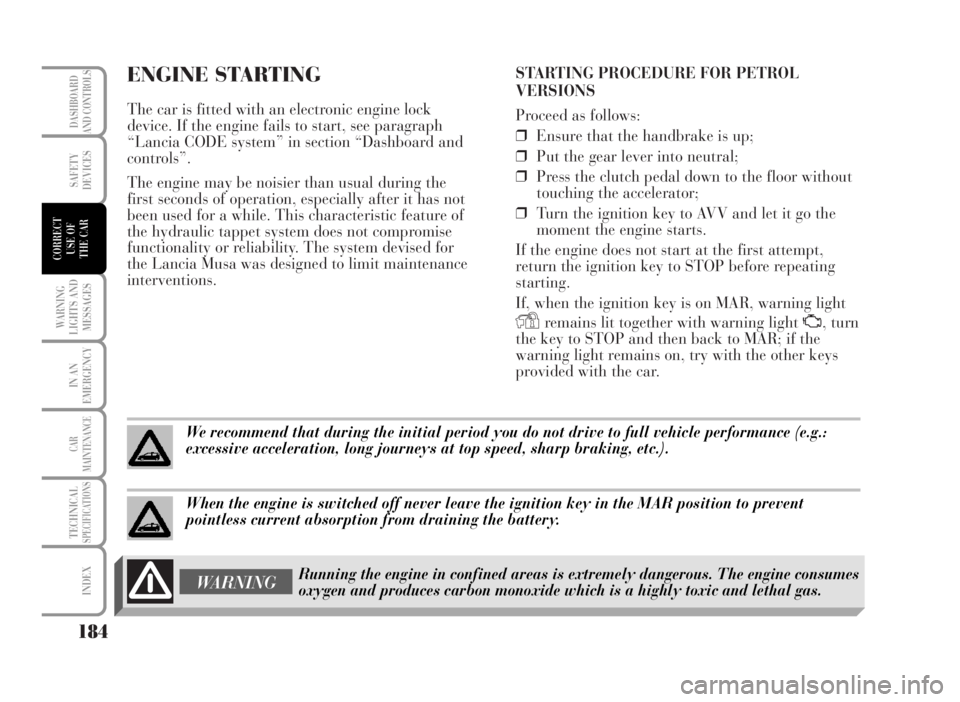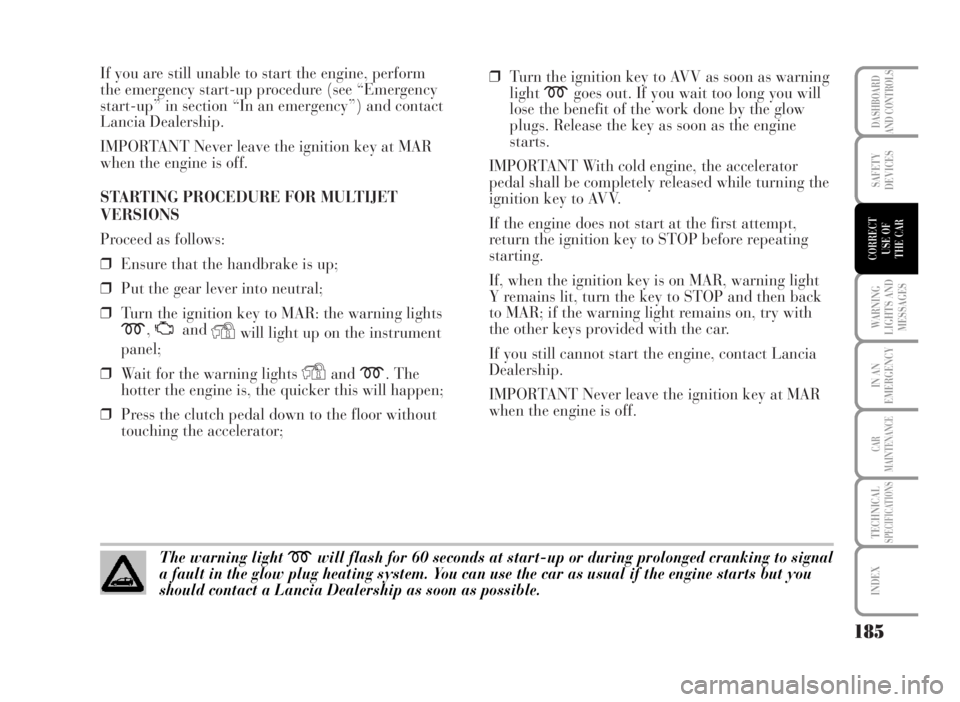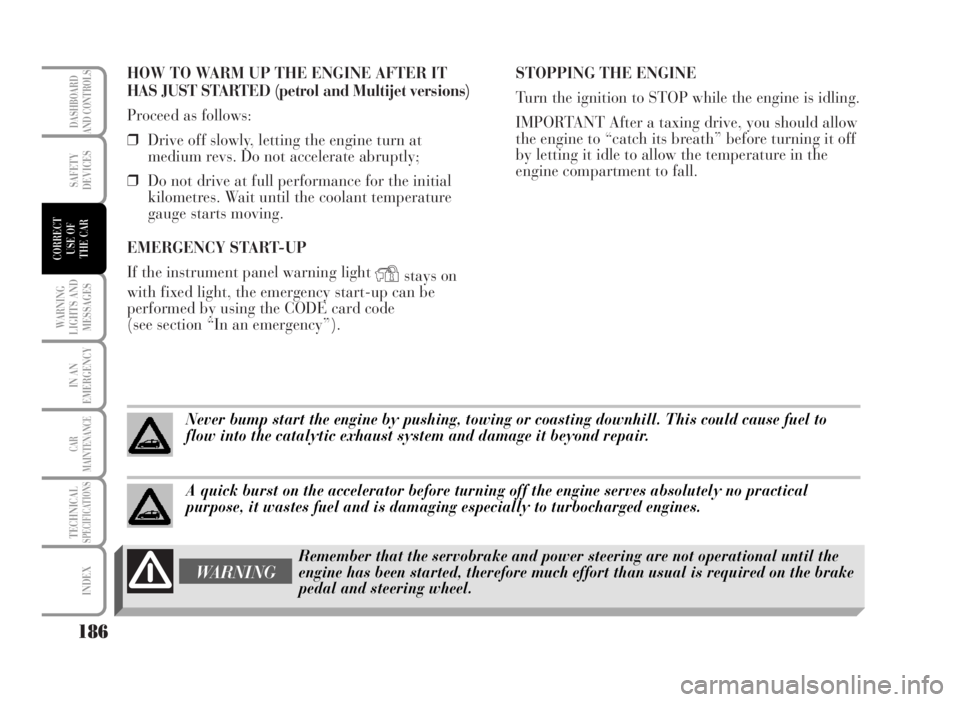engine Lancia Musa 2007 Owner handbook (in English)
[x] Cancel search | Manufacturer: LANCIA, Model Year: 2007, Model line: Musa, Model: Lancia Musa 2007Pages: 346, PDF Size: 5.15 MB
Page 153 of 346

PARKING SENSORS (where provided)
The parking sensors are located on the rear bumper and their function is
to inform the driver, through an intermittent buzzer, about the presence
of obstacles in the rear part of the car.
ACTIVATION
The sensors are automatically activated when the reverse gear is
engaged.
As the distance from the obstacle behind the car decreases, the
acoustic alarm becomes more frequent.
BUZZER WARNINGS
When the reverse gear is engaged an intermittent acoustic signal is
automatically activated.
The acoustic signal:
❒becomes louder as the reduction of distance between the car and
the obstacle decreases;
❒becomes continuous when the distance between the car and the
obstacle is less that 30 cm and stops if the distance raises;
❒is constant if the distance is unvaried. If this situation takes place
for side sensors, the signal is stopped after about 3 seconds to
prevent sound indications when performing manoeuvres near
walls.
Direction distances
The central detecting range varies according to car engine type/set-up
version: detection range is 140 cm. For small size obstacles (or in case
of parking deterrent blocks that are round shaped) it is 70 cm. Side
detecting range is 60 cm.
If several obstacles are detected, the control unit indicates the nearest
one.
152
SAFETY
DEVICES
CORRECT
USE OF
THE CAR
WARNING
LIGHTS AND
MESSAGES
IN AN
EMERGENCY
CAR
MAINTENANCE
TECHNICALSPECIFICATIONS
INDEX
DASHBOARD
AND
CONTROLS
L0D0123m
Page 155 of 346

AT THE FILLING STATION
PETROL ENGINES
Use only unleaded petrol.
To prevent errors, the diameter of the fuel tank
filler is too small to introduce a lead petrol pump
filler. Use petrol with a rated octane number
(R.O.N.) not lower than 95.
IMPORTANT An inefficient catalyst leads to
harmful exhaust emissions, thus contributing to air
pollution.
IMPORTANT Never use leaded petrol, even in small
amount or in an emergency, as this would damage
the catalyst beyond repair.
MULTIJET ENGINES
Operation at low temperatures
If the outside temperature is very low, the diesel
thickens due to the formation of paraffin and could
cause the malfunctioning of the fuel system.In order to avoid these problems, different types of
diesel are distributed according to the season:
summer type, winter type and arctic type (cold,
mountain areas). If refuelling with diesel fuel not
suitable for the current temperature, mix diesel fuel
with TUTELA DIESEL ART additive in the
proportions stated on the can, putting first the
antifreeze in the tank and then the diesel fuel.
If driving or parking the vehicle for a long period in
cold areas/mountains, refuel with the diesel fuel
available at local filling stations.
In this situation you are also recommended to have
in the tank an amount of fuel 50% higher than
usable capacity.
REFUELLING
To guarantee full tank filling, carry out two
refuelling operations after the first click of the fuel
delivery gun. Avoid further topping up operations
that could cause damages to the fuel system.
154
SAFETY
DEVICES
CORRECT
USE OF
THE CAR
WARNING
LIGHTS AND
MESSAGES
IN AN
EMERGENCY
CAR
MAINTENANCE
TECHNICALSPECIFICATIONS
INDEX
DASHBOARD
AND
CONTROLS
The car must only be filled with diesel fuel for motor vehicles, in compliance with European
Standard EN590. The use of other products or mixtures may irreparably damage the engine with
invalidation of the warranty due to the damage caused. In the event of accidentally filling with
another type of fuel, do not start the engine and empty the tank. If the engine has been run even for
only a very short time, in addition to the tank, it is also necessary to drain out the whole fuel
circuit.
Page 157 of 346

PROTECTING THE ENVIRONMENT
The devices for curtailing petrol engine emissions are the following:
❒three-way catalytic converter;
❒Lambda sensor;
❒fuel evaporation system.
In addition, do not let the engine run, even for a test, with one or more spark plugs disconnected.
The devices for curtailing diesel fuel engine emissions are the following:
❒oxidising catalytic converter;
❒exhaust gas recirculation system (E.G.R.);
❒diesel particulate filter (DPF).
DIESEL PARTICULATE FILTER (DPF)
(for 1.3 Multijet 90 HP version)
The Diesel Particulate Filter is a mechanical filter, integral with the exhaust system, that physically traps
particulates present in the exhaust gases of Diesel engines. The diesel particular filter has been adopted to
eliminate almost totally particulates in compliance with current / future law regulations. During normal use
of the vehicle, the engine control unit records a set of data (e.g.: travel time, type of route, temperatures, etc.)
and it will then calculate how much particulates has been trapped by the filter. Since this filter physically
traps particulates, it shall be cleaned (reclaimed) at regular intervals by burning carbon particles.
Reclaiming procedure is controlled automatically by the engine control unit according to the filter conditions
and the conditions of use of the vehicle. During reclaiming the following phenomena could take place: idling
slight increase, fan activation, slight smoke increase, high exhaust temperatures. These situations shall not be
considered as faults and they do not affect vehicle performance and environment. If the dedicated message
is displayed, refer to paragraph “Warning lights and messages”.
156
SAFETY
DEVICES
CORRECT
USE OF
THE CAR
WARNING
LIGHTS AND
MESSAGES
IN AN
EMERGENCY
CAR
MAINTENANCE
TECHNICALSPECIFICATIONS
INDEX
DASHBOARD
AND
CONTROLS
During normal service the catalyst reaches high temperatures. Do not therefore
park the car over inflammable materials (grass, dry leaves, pine needles, etc.):
fire hazard.
WARNING
Page 160 of 346

S.B.R. system
The car is fitted with the S.B.R. system (Seat Belt
Reminder), consisting of a buzzer which, together
with the flashing of warning light
belts.
The buzzer can be deactivated (until the the next
engine stop) as follows:
❒fasten the driver’s seat belt.
❒turn the ignition key to MAR
❒wait for over 20 seconds and then release at least
one of the seat belts.
159
CORRECT
USE OF
THE CAR
WARNING
LIGHTS AND
MESSAGES
IN AN
EMERGENCY
CAR
MAINTENANCE
TECHNICALSPECIFICATIONS
INDEX
DASHBOARD
AND CONTROLS
SAFETY
DEVICES
Remember that in the event of a violent collision, back seat passengers not
wearing seat belts also represent a serious danger for the front seat
passengers.
WARNING
For permanent deactivation, contact Lancia
Dealership.
S.B.R. system can be only reactivated through the
set-up menu (see section “Warning lights and
messages” at paragraph “seat belts not fastened”).
Page 178 of 346

177
CORRECT
USE OF
THE CAR
WARNING
LIGHTS AND
MESSAGES
IN AN
EMERGENCY
CAR
MAINTENANCE
TECHNICALSPECIFICATIONS
INDEX
DASHBOARD
AND CONTROLS
SAFETY
DEVICES
MANUALLY DEACTIVATING PASSENGER'S FRONT AIR BAG
(FRONT AND SIDE BAG) (where provided)
Should it be absolutely necessary to carry a child on the front seat,
the passenger's air bags (front and side bag) can be deactivated.
Air bag deactivation/reactivation takes place with ignition key at
STOP, using the ignition key and the suitable key switch located in
the upper right compartment of the instrument panel
IMPORTANT Operate the switch only when the engine is not running
and the ignition key is removed.
The key-operated switch has two positions:
❒passenger's front air bags (front and side bag) activated (ON
positionP): warning light Fon instrument panel off; it is
absolutely prohibited to carry a child on the front seat.
❒passenger's front air bags (front and side bag) deactivated (OFF
positionF): warning light Fon instrument panel on; it is
possible to carry a child protected by special restraint system on
the front seat.
The warning light Fon instrument panel stays on permanently until
reactivating the passenger's air bags (front and side bag).
The key can be removed when in both positions.
L0D0146m
Page 182 of 346

181
CORRECT
USE OF
THE CAR
WARNING
LIGHTS AND
MESSAGES
IN AN
EMERGENCY
CAR
MAINTENANCE
TECHNICALSPECIFICATIONS
INDEX
DASHBOARD
AND CONTROLS
SAFETY
DEVICES
WARNING
Remember that with the key engaged and in the MAR position, even with the engine
not running, the air bags may be triggered on a stationary vehicle if it is bumped by
another moving car. Therefore, never seat children on the front seat even when the
vehicle is stationary. On the other hand remember that if the key is at STOP, no safe-
ty system (air bags or pretensioners) is triggered in the event of an impact; in these
case, failure to come into action cannot be considered as a sign that the system is
not working properly.
WARNING
WARNING
When the ignition key is turned to the MAR position, the warning light F(with
passenger’s front air bag deactivation, (where fitted), switch in the ON position)
turns on and flashes for few seconds to remind that passenger’s air bag will be
deployed in a crash, after which it should go off.
Do not wash the seat back rest with pressurised water or steam (by hand or at
automatic seat washing stations).
Never travel with objects on your lap, in front of your chest or with a pipe, pencil,
etc. between your lips; injury may result in the event of the air bag being triggered.
WARNING
Page 184 of 346

183
WARNING
LIGHTS AND
MESSAGES
IN AN
EMERGENCY
CAR
MAINTENANCE
TECHNICALSPECIFICATIONS
INDEX
DASHBOARD
AND CONTROLS
SAFETY
DEVICES
CORRECT
USE OF
THE CAR
ENGINE STARTING ............................................. 184
PARKING .............................................................. 187
USING THE MECHANICAL GEARBOX ............... 188
USING THE DUAL FUNCTION
SYSTEM GEARBOX ............................................. 189
CONTAINING RUNNING COSTS.......................... 200
TOWING TRAILERS ............................................ 203
SNOW TYRES ....................................................... 206
SNOW CHAINS ..................................................... 207
CAR INACTIVITY ................................................. 208
CORRECT USE OF THE CAR
Page 185 of 346

ENGINE STARTING
The car is fitted with an electronic engine lock
device. If the engine fails to start, see paragraph
“Lancia CODE system” in section “Dashboard and
controls”.
The engine may be noisier than usual during the
first seconds of operation, especially after it has not
been used for a while. This characteristic feature of
the hydraulic tappet system does not compromise
functionality or reliability. The system devised for
the Lancia Musa was designed to limit maintenance
interventions.STARTING PROCEDURE FOR PETROL
VERSIONS
Proceed as follows:
❒Ensure that the handbrake is up;
❒Put the gear lever into neutral;
❒Press the clutch pedal down to the floor without
touching the accelerator;
❒Turn the ignition key to AVV and let it go the
moment the engine starts.
If the engine does not start at the first attempt,
return the ignition key to STOP before repeating
starting.
If, when the ignition key is on MAR, warning light
Yremains lit together with warning light U, turn
the key to STOP and then back to MAR; if the
warning light remains on, try with the other keys
provided with the car.
184
WARNING
LIGHTS AND
MESSAGES
IN AN
EMERGENCY
CAR
MAINTENANCE
TECHNICALSPECIFICATIONS
INDEX
DASHBOARD
AND CONTROLS
SAFETY
DEVICES
CORRECT
USE OF
THE CAR
We recommend that during the initial period you do not drive to full vehicle performance (e.g.:
excessive acceleration, long journeys at top speed, sharp braking, etc.).
When the engine is switched off never leave the ignition key in the MAR position to prevent
pointless current absorption from draining the battery.
WARNINGRunning the engine in confined areas is extremely dangerous. The engine consumes
oxygen and produces carbon monoxide which is a highly toxic and lethal gas.
Page 186 of 346

If you are still unable to start the engine, perform
the emergency start-up procedure (see “Emergency
start-up” in section “In an emergency”) and contact
Lancia Dealership.
IMPORTANT Never leave the ignition key at MAR
when the engine is off.
STARTING PROCEDURE FOR MULTIJET
VERSIONS
Proceed as follows:
❒Ensure that the handbrake is up;
❒Put the gear lever into neutral;
❒Turn the ignition key to MAR: the warning lights
m,UandYwill light up on the instrument
panel;
❒Wait for the warning lights
Yandm. The
hotter the engine is, the quicker this will happen;
❒Press the clutch pedal down to the floor without
touching the accelerator;❒Turn the ignition key to AVV as soon as warning
light
mgoes out. If you wait too long you will
lose the benefit of the work done by the glow
plugs. Release the key as soon as the engine
starts.
IMPORTANT With cold engine, the accelerator
pedal shall be completely released while turning the
ignition key to AVV.
If the engine does not start at the first attempt,
return the ignition key to STOP before repeating
starting.
If, when the ignition key is on MAR, warning light
Y remains lit, turn the key to STOP and then back
to MAR; if the warning light remains on, try with
the other keys provided with the car.
If you still cannot start the engine, contact Lancia
Dealership.
IMPORTANT Never leave the ignition key at MAR
when the engine is off.
185
WARNING
LIGHTS AND
MESSAGES
IN AN
EMERGENCY
CAR
MAINTENANCE
TECHNICALSPECIFICATIONS
INDEX
DASHBOARD
AND CONTROLS
SAFETY
DEVICES
CORRECT
USE OF
THE CAR
The warning light mwill flash for 60 seconds at start-up or during prolonged cranking to signal
a fault in the glow plug heating system. You can use the car as usual if the engine starts but you
should contact a Lancia Dealership as soon as possible.
Page 187 of 346

HOW TO WARM UP THE ENGINE AFTER IT
HAS JUST STARTED (petrol and Multijet versions)
Proceed as follows:
❒Drive off slowly, letting the engine turn at
medium revs. Do not accelerate abruptly;
❒Do not drive at full performance for the initial
kilometres. Wait until the coolant temperature
gauge starts moving.
EMERGENCY START-UP
If the instrument panel warning light
Ystays on
with fixed light, the emergency start-up can be
performed by using the CODE card code
(see section “In an emergency”).STOPPING THE ENGINE
Turn the ignition to STOP while the engine is idling.
IMPORTANT After a taxing drive, you should allow
the engine to “catch its breath” before turning it off
by letting it idle to allow the temperature in the
engine compartment to fall.
186
WARNING
LIGHTS AND
MESSAGES
IN AN
EMERGENCY
CAR
MAINTENANCE
TECHNICALSPECIFICATIONS
INDEX
DASHBOARD
AND CONTROLS
SAFETY
DEVICES
CORRECT
USE OF
THE CAR
Never bump start the engine by pushing, towing or coasting downhill. This could cause fuel to
flow into the catalytic exhaust system and damage it beyond repair.
A quick burst on the accelerator before turning off the engine serves absolutely no practical
purpose, it wastes fuel and is damaging especially to turbocharged engines.
Remember that the servobrake and power steering are not operational until the
engine has been started, therefore much effort than usual is required on the brake
pedal and steering wheel.
WARNING